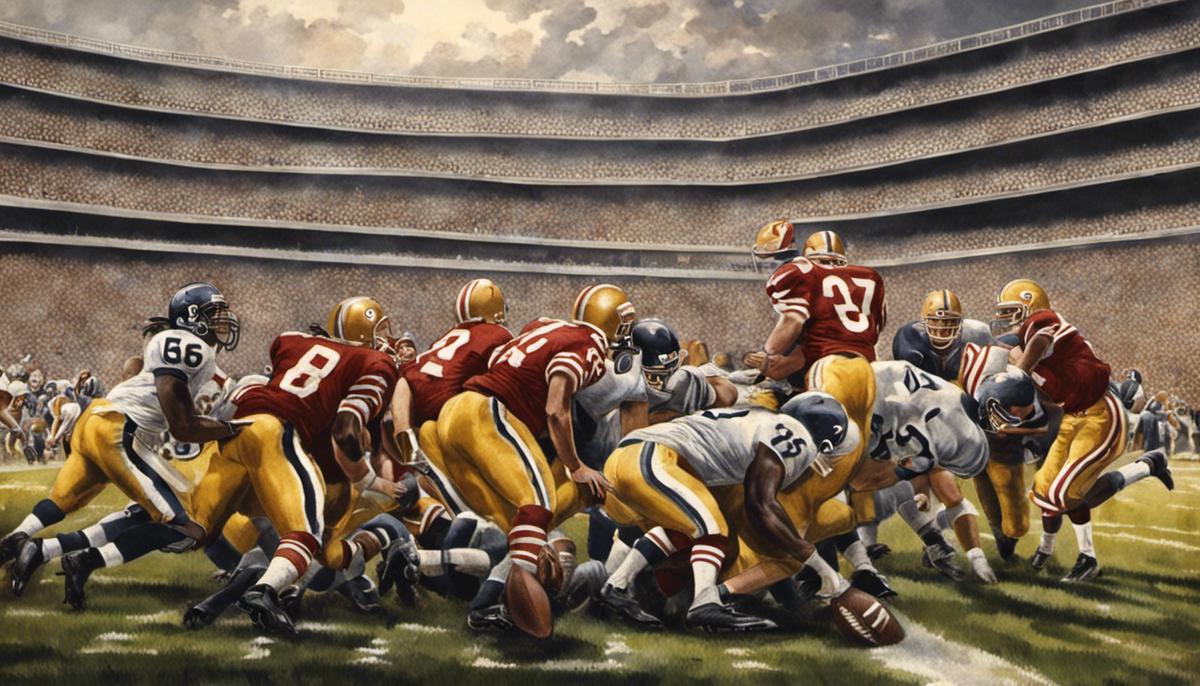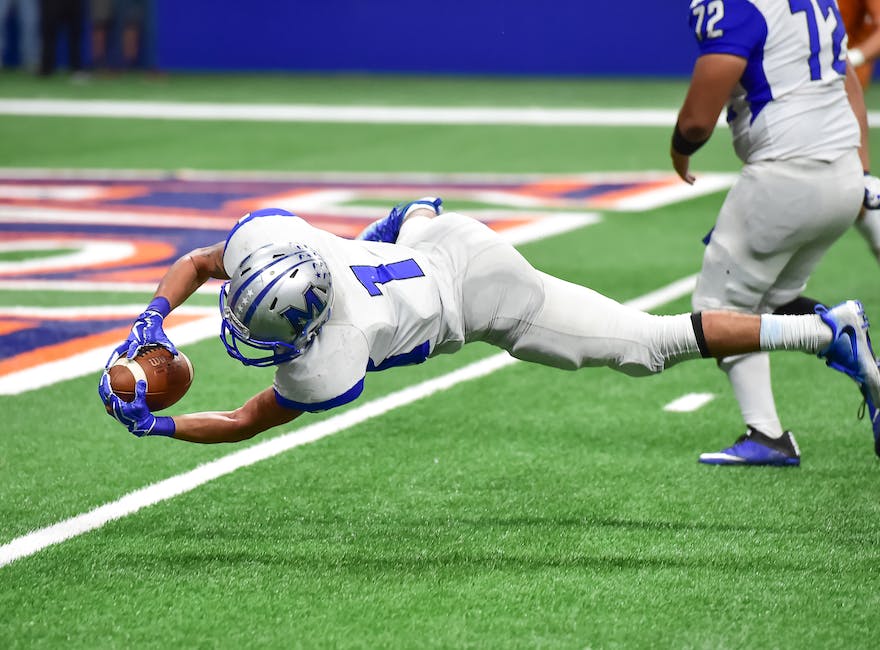With roots dating back to the mid-19th century and inspired by soccer and rugby, American football has undergone a notable transformation to carve out its distinct identity. Enmeshed in the fabric of American society, it is not just a sport but a cultural phenomenon affecting various aspects of the American way of life. This narrative traces the evolution of American football, beginning with its embryonic stages, and explores the significant changes throughout numerous eras that led to the establishment and progression of the National Football League (NFL). It also delves into the far-reaching cultural influences of this epoch-making sport, underscoring its representation in popular culture, societal impact, and the financial powerhouse it has become.
Origins and Early Development of the Game
The Origins of American Football
The roots of American football can be traced back to the mid-19th century, inspired by two popular games at the time: soccer and rugby. The game as we know it today took shape in the United States, hence the name American Football. This game’s journey from rudimentary forms to a well-structured sport with defined rules and regulations was gradual but transformational.
In the early 19th century, American universities began playing a football-like game, much like the game we know today. These early versions of football, generally related to what English public schools called “mob football,” involved an indefinite number of players on each team who would try to advance the ball to the opposing team’s goal.
The Formation of Intercollegiate Football
It wasn’t until November 6, 1869, that the first game of intercollegiate football was played. Rutgers University took on Princeton University in what would be the beginning of the transformation from rugby-style play to the all-American football we know today.
Though the game was played with a round ball and each team had 25 players, the game marked a significant milestone in the history of American football. This game sparked the inception of structured collegiate football leagues and spawned a new kind of spectator sport.
The Influence of Walter Camp
One man greatly responsible for the evolution of American football was Walter Camp, now often referred to as the “Father of American Football.” As a Yale University and Hopkins School student, Camp played football and, in 1878, began attending the conventions where the game’s rules were crafted and shaped.
Camp proposed the critical innovation that teams should be reduced to eleven men each and the establishment of the scrimmage – the precursor to the modern line of scrimmage. Other innovations introduced by Camp include the concept of downs and the distance needed for a first down, which fundamentally changed the game’s passive nature and turned it into a game of strategy and skill.
The Evolution of Professional Football
Professional football as we know it today made its debut in the 1890s. The Allegheny Athletic Association and the Pittsburgh Athletic Club were among the first teams that comprised what became the National Football League (NFL). It was small, disorganized, and, unlike college football, not highly popular, but it was the beginning of what has become the most popular sport in the United States.
Despite challenges, the professional game continued to grow and improve over the next several decades, and in 1920, the American Professional Football Association was formed. The APFA would be re-baptized just two years later as the National Football League (NFL).
In 1936, the NFL introduced the first player draft, creating a more level playing field by ensuring lower-ranking teams had the opportunity to recruit better players. This step fostered a sense of fairness and competition that remains a fixture of professional football today.
Integrated Football
American football, much like the nation itself, was divided along racial lines for much of its early history. After Fritz Pollard and Bobby Marshall began playing in the NFL in 1920, the league tacitly banned African Americans in 1934. However, this racial barrier would be re-broken following World War II, when Pollard guided four replacement players into the NFL in 1946. Since then, football has been at the forefront of sports-based civil rights efforts.
A Glimpse at Modern American Football History
From modest beginnings, American football has shaped dramatically since its inception. The American Football League (AFL), created in 1960, instigated massive competition, both on and off the field, with the already established National Football League (NFL). This rivalry led to an amalgamation in 1970, establishing the NFL’s structure we recognize currently. The NFL was divided into two distinct conferences – the American Football Conference (AFC) and the National Football Conference (NFC).
The intricate journey of American football history tells the tale of a humble mob football game in colleges evolving into the strategic, professional sport it is today. With the continuous adaptation of rules, advancements in playing techniques, and the growth of a passionate fanbase, American football has undoubtedly cemented itself into the core of American culture.

Significant Changes and Developments Through the Years
Exploring Key Transformations in American Football
The evolution of American football to the game we see today is a testimony of crucial transformations over the years. Let’s dive into the restructuring of the fundamental rules. In its nascent stage, a round ball was employed in American football, with players following a blend of soccer and rugby rules. However, Walter Camp, fondly hailed as the “Father of American Football,” ushered in a series of game-changing directives in the late 19th century, including introducing the line of scrimmage, downs, and an all-new scoring system.
The turning point for American football came in 1905 when concerns over the sport’s inherent violence, which had led to catastrophic injuries and even deaths, became prevalent. President Theodore Roosevelt’s intervention led to a much-needed revamp of football rules to reduce excessive bone-crushing brute force. This led to the inception of the Intercollegiate Athletic Association, now known as the NCAA. Under their vigilant governance, the forward pass was sanctioned, forever altering the game’s strategies and nature.
Notable Figures and Game Strategies
Some key figures over time have had significant impacts on the sport. Paul Brown, the eponymous founder of the Cleveland Browns in the 1940s, is credited with several innovations that professionalized the sport, including detailed player scouting, film study, and radio transmitters to communicate with players on the field.
Over time, a crucial aspect of the game that evolved has been the strategies and playing styles. For instance, the forward pass originally introduced to make the game safer, began to dominate offensive strategies by the 1980s, thanks to influential coaches and players like Bill Walsh and Joe Montana of the San Francisco 49ers.
The Influence of Industrial Evolution and Global Wars on American Football
Football, a popular sport in America, was profoundly shaped by the profound shifts in global society. For instance, the industrial revolution in the late 19th century, which spurred urbanization and improved living conditions, led to increased leisure time amongst the population. As a result, spectator sports such as football rapidly gained popularity.
World War I and II also played a significant role in the evolution of football. Numerous players either enlisted voluntarily or were drafted into the military, causing several seasons to be disrupted. Simultaneously, these wars prompted technological advancements, specifically in communication and transportation. The post-World War II era experienced a boom in the accessibility of television and radio, paving the way for football games to be broadcast widely, further amplifying the sport’s popularity.
Post the war, the economic prosperity witnessed by the nation facilitated the expansion of professional football leagues and the construction of expansive football stadiums. These factors collectively contributed to the transformation of American football into the highly watched and revered sport it is today. The evolution of rules, influential figures involved, and societal shifts have all significantly shaped the history of this popular sport in America.

Establishment of the NFL and Its Progression
Birth of the National Football League
The year 1920 was a landmark one in the history of American football as the American Professional Football Association (APFA) was founded. The primary purpose of this organization was to prevent a common issue of the time – teams poaching players from one another. In merely two years, the APFA underwent a transformation and was renamed the National Football League (NFL) that we are familiar with today. The NFL was initially comprised of just 14 teams, a number that pales in comparison to the 32 teams that represent the league today.
Super Bowl Era
The Super Bowl quickly became a massive cultural event in America and a de facto national holiday. The first Super Bowl was held in 1967, following the merger of the NFL and AFL, with the Green Bay Packers emerging victorious over the Kansas City Chiefs. The Super Bowl has evolved as an annual spectacle highlighting not just the sport itself but also memorable halftime shows and attention-grabbing commercials, cementing the NFL’s place in popular culture.
Controversies and Safety Issues
Over the years, the NFL has been plagued by various controversies, including player conduct, team relocation, and more notably, health and safety concerns. The most significant of these is the issue of concussions and the permanent neurological damage they can cause.
In 2002, notable pathologist Dr. Bennet Omalu first discovered Chronic Traumatic Encephalopathy (CTE), a neurodegenerative disease, in the brains of deceased NFL players. Omalu’s findings ignited a long-standing debate regarding the safety of the sport. Over time, numerous NFL players have come forward to reveal their struggles with head injuries, leading to increased scrutiny of the league’s handling of player health.
Despite initial resistance, the NFL has since acknowledged the link between football and CTE and has introduced new rules and protocols concerning head injuries. These changes include reducing contact during practices, altering tackle rules in the game, and implementing a concussion protocol for players suspected of sustaining a concussion.
Modern Trends
Since its commencement, the NFL has had steady viewership. However, modern trends show a fluctuating pattern, with regular-season viewership peaking in 2015 at approximately 18 million viewers per game. This number dropped slightly in the following years due to several factors, including controversial political statements by players, changing viewer habits, and competition from other entertainment sources.
Despite these challenges, the NFL has remained a dominant force in American sports culture. Its most recent seasons have shown some recovery in viewership numbers. Efforts to adapt to the changing media landscape, such as partnerships with streaming services and social media platforms, represent a potential path forward for the league.
The NFL: A Significant Influence on American Culture
The National Football League (NFL) is more than just a sporting organization; it’s an influential part of American life, leaving an indelible footprint on the societal landscape. Grasping the origins, controversies, and present status of the NFL is not solely a source of intrigue for sports enthusiasts, but it’s also crucial for understanding the cultural dynamics of America.

Cultural Impact of American Football
The Implication of American Football on American Life
Football has melded with the everyday life of Americans, becoming a staple element of the nation’s socio-cultural identity.
Come autumn, unity is displayed in the form of robust support for professional, college, or high school teams across towns, cities, and the whole nation. It’s a spectacle that unifies people, regardless of their diversity, and brings about a sense of communal belonging.
Football in Popular Culture
Football has been represented in popular culture through various forms, like films, TV shows, books, and music.
Hollywood productions such as “Remember the Titans,” “Friday Night Lights,” and “Rudy” have immortalized the sport on the silver screen, capturing its exhilarating essence while addressing serious societal issues such as racial integration.
Unifying Force
American football also acts as a unifying force – bringing together people of all races, backgrounds, and walks of life.
It embodies the melting pot characteristic of America, showcasing diversity not only in the players but also in the fanbase.
This unity is often seen in Tailgating culture, where fans from different backgrounds come together to enjoy food, drink, and camaraderie before a game.
Economic Impact
The sport has not only influenced America’s societal fabric, but it also has a significant economic impact.
According to a report, the National Football League (NFL) contributed approximately $15 billion to the U.S. economy in 2019.
It generated employment across various sectors, from construction for stadiums to jobs in the hospitality industry.
The Super Bowl, one of the most-watched sports events globally, contributes hugely to the local economy of the hosting city.
Role in Education
Furthermore, football has an integral role in the American education system.
From a young age, children are encouraged to participate in the sport.
Many high schools and colleges offer football scholarships, offering young athletes a chance at quality education coupled with an opportunity to pursue their passion for the sport.
Agent for Change
Football’s prevalence in American society and culture has been an agent of change over the years.
Be it racial integration in “Remember the Titans” or tackling societal norms in “Rudy,” the sport has proven to be a catalyst in the process of change, reflecting and affecting social norms and attitudes.
Continued Dominance
Despite its share of criticism regarding safety and health impacts, American football continues to dominate the country’s sporting landscape.
Its impact and influence across the numerous aspects of American life is a testament to its more than a century-old legacy.
Football has been, and will likely remain, more than just a game for Americans – it is a quintessential part of their identity.

Through the lens of time, it is evident that American football has grown vastly, metamorphosing from a rudimentary form of sport into a cultural and economic powerhouse. Its journey mirrors the growth and shifts in American society, from the influence of the Industrial Revolution and global wars to the establishment of the NFL and the pivotal changes within. It underlines an engrossing narrative about resilience, innovation, and unity, at times highlighting controversies while promoting diversity and serving as a unifying force. This embodiment of America’s rich tapestry has permeated educational systems and left an indelible imprint on popular culture, further reinforcing its significant place in American history.




